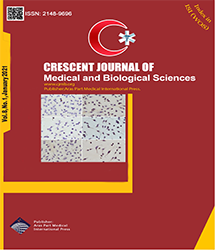
| Original Article | |
| Chemical Variation in Essential Oil Composition and Rosmarinic Acid Content in Rosemary From Iran at Different Harvesting Times During One Day | |
| Mohammad Kazem Rofouei1, Seyed Momen Hejazi Kojoori1, Roudabeh Sadat Moazeni-Pourasil1 | |
| 1Faculty of Chemistry, Kharazmi University, Tehran, Iran | |
|
CJMB 2021; 8: 048-055 Viewed : 3741 times Downloaded : 17211 times. Keywords : Rosmarinus officinalis L., Essential oil, Hydroxycinnamic acid, Harvesting time |
|
| Full Text(PDF) | Related Articles | |
| Abstract | |
Objectives: Rosemary has been broadly used in food, cosmetic, and pharmaceutical industries due to having different groups of main secondary metabolites (phytochemicals). There are many ways to reach the aim of the maximum percentage of active compounds. Regarding the importance of the essential oil (EO) and hydroxycinnamic acid derivatives, as well as ease of the harvesting time control, these factors were selected in this study although the variations of the chemical content of rosemary were evaluated during one day contrary to previous reports. Materials and Methods: The fresh aerial parts of the cultivated rosemary were hand-harvested in winter at three different times (i.e., before sunrise, at noon, and after sunset) and then dried at 30°C. Each sample was submitted to the Clevenger-type apparatus for the isolation of the EO. The dried EOs were analyzed by gas chromatography (GC)/flame ionization detector (FID) and gas chromatography-mass spectrometry (GC/MS), and total hydroxycinnamic acid derivatives were determined by the UV/Vis spectrophotometer. Finally, the results were validated by the ANOVA test. Results: The maximum (3.65%) and minimum (1.61%) of the total EO were obtained before the sunrise and after the sunset with 24 and 26 components, respectively. In addition, the results of GC/MS revealed that 1, 8-cineole, α-pinene, and camphor are the three most dependable components in the EO to the harvesting time. The contents of α-pinene and 1,8-cineole reduced from 32.8% to 23.0% and from 23.6% to 10.5% although the camphor percentage increased from 2.7% to 9.8% in the variation of the harvesting time from before the sunrise to after the sunset. In contrary to the EO, UV/Vis spectrophotometry results showed that hydroxycinnamic acid derivative contents were undependable over different harvesting times. Conclusions: Based on this investigation, rosemary can change their component in some groups, and thus the harvesting time can be optimized based on our needs. |
Cite By, Google Scholar
Google Scholar
PubMed
Online Submission System
 CJMB ENDNOTE ® Style
CJMB ENDNOTE ® Style
 Tutorials
Tutorials
 Publication Charge
Medical and Biological Research Center
About Journal
Publication Charge
Medical and Biological Research Center
About Journal
Aras Part Medical International Press Editor-in-Chief
Arash Khaki
Deputy Editor
Zafer Akan


















